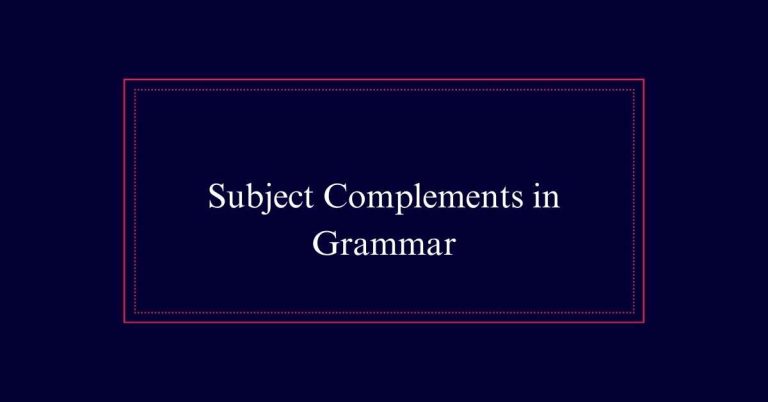How to Use Adjectives With Sense Words?
Using adjectives with sense words is essential for creating clear and vivid descriptions in your writing. Sense words like ‘see,’ ‘hear,’ ‘smell,’ ‘taste,’ and ‘feel’ should always be followed by adjectives. Adjectives describe what is perceived, such as ‘delicious’ in ‘The soup tastes delicious.’ Avoid using adverbs after sense verbs; instead, choose an appropriate adjective.
Sense Words Overview
Sense words are verbs that relate to the five senses: sight, sound, smell, taste, and touch. Examples include ‘see,’ ‘hear,’ ‘smell,’ ‘taste,’ and ‘feel.’ These verbs help describe how we perceive the world around us.
When using sense words, it is important to follow them with adjectives, not adverbs. Adjectives provide more information about the noun being sensed. For instance, ‘The soup tastes delicious’ is important because ‘delicious’ is an adjective describing the soup.
Adjectives Vs. Adverbs
Understanding the distinction between adjectives and adverbs is essential for mastering clear and effective writing. Adjectives describe the qualities of nouns, while adverbs modify verbs, adjectives, and other adverbs.
For instance, in the sentence ‘The cake tastes sweet,’ ‘sweet’ is an adjective describing the noun ‘cake.’ Conversely, in ‘She sings beautifully,’ ‘beautifully’ is an adverb modifying the verb ‘sings.’
Adjectives are particularly important with sense verbs like ‘feel,’ ‘smell,’ and ‘look.’ Using adverbs in these contexts, such as ‘I feel happily,’ is incorrect. Instead, ‘I feel happy’ is the correct form.
Using Adjectives Correctly
Correctly using adjectives enhances the clarity and precision of your writing, especially when paired with sense verbs. Sense verbs like ‘feel,’ ‘smell,’ ‘look,’ ‘sound,’ and ‘taste’ require adjectives to describe the noun they modify.
To use adjectives correctly:
- Identify the sense verb: Determine if the verb relates to one of the five senses.
- Choose the right adjective: Use an adjective that accurately describes the noun.
- Avoid adverbs: Adverbs should not be used after sense verbs.
- Verify for clarity: Ascertain the adjective makes the sentence clear and precise.

Common Mistakes
Writers often make common mistakes when using adjectives with sense verbs, leading to unclear or incorrect sentences. One frequent error is using adverbs instead of adjectives. For example, writing ‘The soup smells wonderfully’ is incorrect; ‘The soup smells wonderful’ is correct.
Another mistake is placing adjectives incorrectly, such as ‘He looks tiredly’ instead of ‘He looks tired.’ Misunderstanding the role of sense verbs can also cause errors. Sense verbs like ‘feel,’ ‘seem,’ and ‘taste’ require adjectives, not adverbs. Failing to recognize this distinction leads to confusing sentences.
Examples of Proper Usage
Examples of proper usage can illustrate how to effectively pair adjectives with sense verbs. Here are some examples that demonstrate this:
Taste:
‘The soup tastes delicious.’
- The adjective ‘delicious’ complements the sense verb ‘tastes.’
Touch:
‘The blanket feels soft.’
- The adjective ‘soft’ complements the sense verb ‘feels.’
Sound:
‘The music sounds soothing.’
- The adjective ‘soothing’ complements the sense verb ‘sounds.’
Smell:
‘The flowers smell fragrant.’
- The adjective ‘fragrant’ complements the sense verb ‘smell.’
Adjectives for Sight
In the domain of sight, adjectives play an essential role in vividly describing visual experiences. They help paint clear and precise images in the reader’s mind.
For example, consider the difference between ‘a house’ and ‘a charming house.’ The adjective ‘charming’ adds a layer of meaning and emotion. Similarly, ‘bright colors’ evoke a stronger visual image than just ‘colors.’ Adjectives like ‘gloomy,’ ‘sparkling,’ ‘dim,’ and ‘vibrant’ provide specific details that enhance descriptions.
Adjectives for Sound
Describing sounds with adjectives can transform ordinary writing into an immersive auditory experience. Using the right adjectives helps readers ‘hear’ the scenes.
Consider these examples:
- Loud: This adjective conveys high volume. ‘The loud music filled the room.’
- Melodious: It describes pleasant sounds. ‘The melodious song calmed everyone.’
- Harsh: Use this for unpleasant sounds. The harsh noise startled the baby.
- Faint: It indicates low volume. ‘She heard a faint whisper in the dark.’
Adjectives for Smell
Just as adjectives can bring sounds to life, they can also vividly describe scents. Adjectives for smell are essential in creating a clear and specific picture in the reader’s mind. Words like ‘fragrant,’ ‘pungent,’ ‘musty,’ and ‘aromatic’ convey distinct olfactory experiences.
For example, ‘The garden is fragrant with blooming roses’ gives a vivid sense of the pleasant aroma. Conversely, ‘The room is musty’ indicates a stale and unpleasant smell. Using precise adjectives for scent not only enhances imagery but also evokes emotions and memories linked to those smells.
Adjectives for Taste
Taste adjectives are essential for conveying the specific flavors of food and drink. They allow us to describe our culinary experiences accurately and vividly. When discussing taste, the adjectives used can range from basic to complex, helping to paint a complete picture of the flavor profile.
Here are some common taste adjectives:
- Sweet: Describes foods like candy and fruit.
- Sour: Used for items such as lemons and yogurt.
- Bitter: Applicable to foods like dark chocolate and coffee.
- Salty: Characterizes snacks like chips and pretzels.
Adjectives for Touch
While taste adjectives help convey flavors, touch adjectives describe the texture and feel of objects or surfaces. These adjectives provide sensory detail that enhances writing.
For example, words like ‘smooth,’ ‘rough,’ ‘slippery,’ and ‘sticky’ help readers visualize and experience the described object. Using touch adjectives appropriately can make descriptions more vivid and tangible.
Consider the difference between ‘the table feels smooth’ and ‘the table feels smoothly.’ The former correctly uses an adjective after the sense verb ‘feels,’ while the latter incorrectly uses an adverb.






